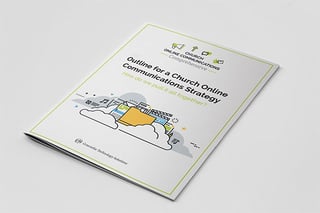
This is the fourteenth and final post for our training course Church Online Communications Comprehensive. After covering everything from setting church goals to writing persona profiles, it’s time to put it all together, develop a strategy, and implement the strategy. Here are the answers to some common questions about rolling out an online communication strategy at your church.
How should I introduce the strategy?
If you are a one-person communications team, I recommend you begin talking about the strategy now. Share your ideas with other members of your ministry team and with your church-communication peers to get feedback. If you are part of a multi-person communications team, talk through each part of the strategy with your team, and get and apply their input throughout the process.
Then when the strategy is finalized, present it to your ministry team in a visual, high-level manner. The team doesn’t need to read the entire strategy, but you should help them understand the components and how those elements apply to your work. Most importantly, explain what will change in the church’s communications and why.
When should I introduce the strategy?
The best time will vary from church to church. Some good times may be the beginning of a new school year, church year, or calendar year, or when summer starts.
Keep in mind that implementing this strategy will be a gradual process and will take time for everyone to get used to. It’s not the same as a re-branding, which requires an official launch date. A communication strategy requires testing and fine-tuning, and you don’t know what you’ll need to tweak until you start.
How do I encourage the church staff and volunteers to follow the communication strategy?
The most important thing to convey to others is the value of the communication strategy. When people understand the why, they’re more likely to support the how and make changes themselves. The why for your church is probably something along the lines of “so our communications can be more effective and efficient and so our church can reach a wider audience.”
You may encounter people who don’t understand the value of implementing a communication strategy, who refer back to the power of the Holy Spirit and relying on Him to share the Gospel. Those people aren’t wrong; they may just be viewing your strategy through a different lens. You may be able to help them see the value in your communication strategy by emphasizing that church communication is not about converting people; it’s about creating opportunities for people to hear the Gospel. A good communication strategy leverages the tools that are available and makes good use of time, talent, and treasures. It’s much more about stewardship than evangelism.
What if the strategy isn’t effective?
Some of the things you do won’t work, and that’s ok. Thomas Edison is quoted as saying, “I have not failed. I’ve just found ten thousand ways that won’t work.” Your “failures” are really just opportunities to learn and improve. Plus, what works for one church won’t necessarily work for another, and it will take time to learn what works best for your audience.
How do I find time to put a communication strategy together?
Just do a little bit at a time, starting at the beginning and backtracking as necessary as new ideas come to mind. The great thing about a communication strategy is that it doesn’t require an all-or-nothing approach. Even if you start at the very end by putting together a single campaign template, your communications will still be better off.
I like to think of this silly joke: “How do you eat an elephant? One bite at a time.” As you approach a communication strategy for your church, I suggest you take these “bites” first.
- Identify your church’s goals. Without a destination, you can’t figure out what steps to take. Even if your church doesn’t have defined goals, there are certainly unspoken ones.
- Determine at least two personas. Start tailoring your messages for your audience. Those people will appreciate that the messages they receive are more relevant to them.
- Draft a journey map. Make a quick first attempt at a journey map, then test it out by talking with people who are at or near the end and see how they got there. You’ll probably find that you need to make a couple changes.
You can begin these things with just a fifteen-minute evaluation of your church. Then you have a start, and you can only move forward.

Ready to wrap up your strategy?
This week, we have two free downloads. The first is an outline of a communication strategy so you can have a comprehensive reminder of what yours should include. The second is a template you can fill in to keep everything for your church’s strategy in one place.
Free Training Course
This blog post was part of the training series Church Online Communications Comprehensive. All the course materials are available online for free, and you can move through the course at your own pace. Start working toward an effective online communication strategy for your church today!
About the Author
Follow on Linkedin More Content by Peter Frank
























